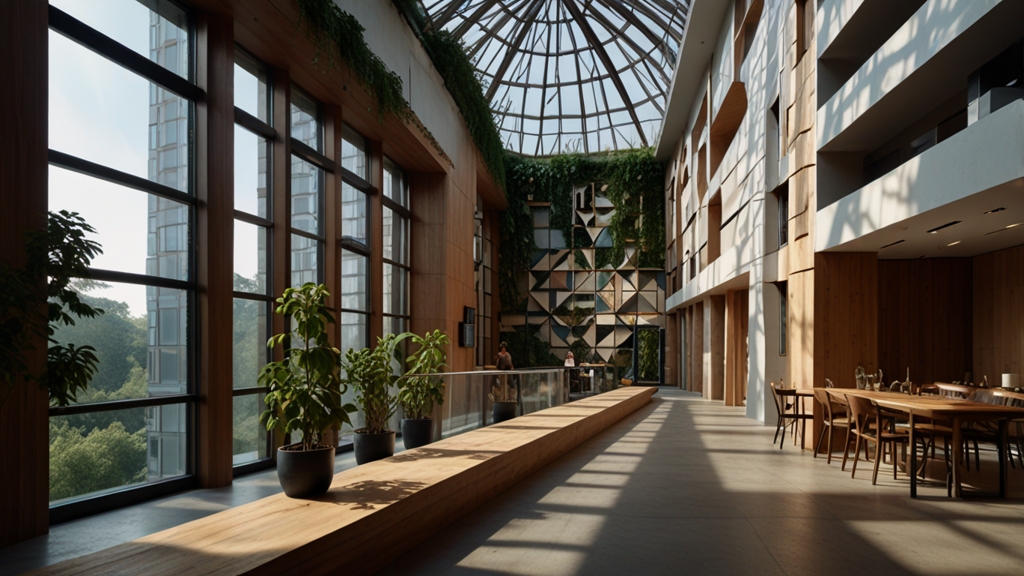The Role of Geometry in Sustainable Design
Geometry, the branch of mathematics concerned with the properties and relationships of points, lines, surfaces, and solids, plays a crucial and often underappreciated role in sustainable design. Sustainable design aims to minimize negative impacts on the environment through thoughtful choices in design, material selection, and building methods. By leveraging geometric principles, architects and designers can enhance a structure’s energy efficiency, reduce waste, and promote longevity, contributing to a more sustainable future.
Optimizing Energy Efficiency
One of the ways geometry contributes significantly to sustainable design is by optimizing energy efficiency. The shape and orientation of a building can significantly impact its energy consumption. For example, buildings with shapes that maximize natural light reduce the need for artificial lighting, which in turn lowers electricity consumption. Geometric shapes like the cube and the sphere are often used for their superior insulation properties; a cube has a lower surface-area-to-volume ratio, which minimizes heat loss.
"Geometry helps us understand the intrinsic principles of nature. By applying these principles thoughtfully, we can design buildings that are not only aesthetically pleasing but also exceptionally energy-efficient." — Architect Sarah Natterson
Building orientation is another crucial aspect where geometry plays a vital role. A building designed with the longer side facing south can take advantage of the winter sun while minimizing heat gain in the summer, thereby reducing the need for heating and cooling systems. Advanced geometric modeling tools can simulate sunlight exposure and heat gains, providing invaluable data for making informed decisions about orientation and shape.
Reducing Material Waste
Geometry also assists in minimizing material waste during construction. The use of modular and prefabricated geometric elements can lead to more efficient use of resources. For example, in modular construction methods, elements are produced in controlled environments and then assembled on-site. This not only reduces waste but also decreases the energy spent on transportation and reduces the overall construction time.
"By embracing modular design, we can significantly cut down on material waste and resource consumption. Geometry is at the core of these innovative construction techniques." — Sustainability Expert John Bartlett
Moreover, geometric optimization can identify the best ways to cut materials to ensure minimal waste. Techniques such as tessellation, where shapes are arranged without gaps or overlaps, can be applied to maximize the usage of raw materials like metal sheets or fabric, reducing both waste and cost.
Enhancing Longevity and Adaptability
Sustainable design is not just about minimizing initial environmental impact; it’s also about ensuring that buildings are adaptable and durable. Geometric principles can be applied to create structures that are not only structurally sound but also capable of adapting to future needs. For example, using geometric analysis, designers can create flexible spaces that can be easily reconfigured for different uses, thus extending the building’s lifecycle and reducing the need for demolition and reconstruction.
Additionally, complex geometric forms inspired by nature, known as biomimetic designs, can be used to create structures that are incredibly robust yet flexible. Such designs can enhance a building's ability to withstand natural disasters like earthquakes or hurricanes, thereby reducing the need for repairs and prolonging the building’s lifecycle.
Conclusion
In the quest for sustainable design, geometry offers a valuable toolkit. From optimizing energy efficiency and reducing material waste to enhancing the longevity and adaptability of structures, geometric principles provide the foundation for creating buildings that are both environmentally responsible and resilient. As technology continues to advance, the integration of geometry in sustainable design will undoubtedly lead to even more innovative and impactful solutions.









